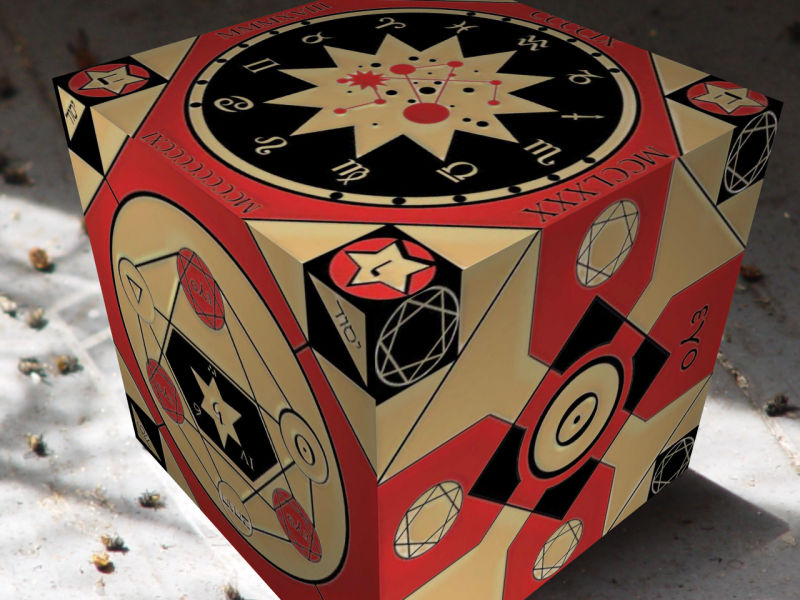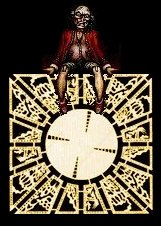ALBERTUS MAGNUS'
A Daemonibus Docetur
"The Key To One's Ultimate Truth"
Art
research by Guillaume Roos

ALBERTUS MAGNUS'
A Daemonibus Docetur
"The Key To One's Ultimate Truth"
Art
research by Guillaume Roos

Comte de Saint Germain was an 18th-century adventurer known as 'Der Wundermann' - 'The Wonderman'.Passages from the diary of the Comte de Saint Germain:
Paris, 1749 AD
"I recently discovered this strange box in the archives of the masonic lodge 'Grand Orient de France' in Paris, of which I am part. It made me think immediately of one of the music boxes Msr. Philippe Lemarchand produces, and which I intend to purchase. But, according to the documents that I found with it, this very box is much older."
"These documents, which some think might have been written by Christian Rosencreutz, founding father of the Rose-Croix, explain this box. 'The Key to one’s Ultimate Truth' as it's called, would have been produced around the year 1275 by the well known alchemist Albert le Grand, (Albertus Magnus as he is referred here), and might be the key to the fullfilment of one’s ultimate quest for truth."
"I have been studying this object for a few weeks now, and here are my conclusions at this point:
According to the writer of the documents, it seems to have been made with three different metals: The light parts with a gold based alliage, the dark parts with lead, and the red parts with an unknown alliage. The only thing the writer seems to know for certain about this last alliage is that human blood was part of its composition."
"The box's six different sides each explore a different domain. To make my study easier, I have given them the following names:
'The Invocation Circle', 'The Calendar', 'The Kabbalistic Tree', 'The Exorcism Circle', 'The Vulgar State', and 'The Golden State'".
"This is where the study has taken me so far. The thoughts of Magnus are still a mystery to me, but I’m starting to see the links between the panels of the sides. The only thing I still miss is the key. Maybe the solution is in the blood..."
This is the last known page written by the Comte de Saint Germain about the "Key to One’s Ultimate Truth".
Comte de Saint Germain
He was a man whose origin was unknown and who disappeared without leaving a trace.
Saint Germain never seemed to age. For an entire century he maintined the physical appearance of a man between forty and fifty years old.
He could do just about anything. He was a magician, a musician, artistry as a violinist, talent as a painter, skill in alchemy and chemistry, a seer who read for and socialized with the rich and famous, had great wealth, and was one of the most mysterious men on the Europe continent.
He knew nearly all the European languages. His knowledge of history was comprehensive, and his accomplishments as a chemist, on which he based his reputation, were in many ways considerable.
By far the greatest obvious talents of the Comte de Saint-Germain were connected with his knowledge of alchemy. Yet if Saint-Germain knew how to make gold, he was wise enough to say nothing about it. Nothing but the possession of this secret could perhaps account for the enormous wealth at his command, though he was not known to have money on deposit at any banks.
He was one of the of the most celebrated mystics and adventurers of his time. He was a confidant of two kings of France, a dazzlingly rich and gifted social figure, the subject of a thousand rumors.
From 1750, the Comte starts to become quite famous throughout all Paris and after that all Europe. He rapidly acquired the reputation of being incredibly rich and wise. He was an aristocrat who lived with princes and even with kings almost on a footing of an equal.
One of his principal roles was that of a secret agent in international politics in the service of France. He became Louis XV's confidential and intimate counselor and was entrusted by him with various secret missions.
Matters came to a head in 1760, when the count at the behest of the king involved himself in foreign affairs, going behind the back of ministry. Threatened with arrest, he was obliged to flee to England, where he stayed for a while; possibly for a period of two years.
From England Count Saint-Germain apparently went to Russia, where it is claimed he took part in a conspiracy that put Catherine the Great upon the throne in 1762.
Secret Societies
Secret societies were the fashion in pre-revolutionary France, and some of them recognized Saint-Germain as an 'adept' one who knew the ancient wisdoms hinted at in the rites of the Freemasons, Rosicrucians and Knights Templars.
He influenced Freemasonry and the secret societies, though many modern masons have denied this and have even omitted to mention him as a great source of inspiration.
In Germany there were the Illuminati and the Knights of Strict Observance, and Frederick II, when he came to the throne, founded the sect of the Architects of Africa.
In France, the Order of the Templars was reconstituted, and Freemasonry, whose grand master was the Duke de Chartres, increased the number of its lodges in every town.
The initiates of these sects understood that they were the depositories of a heritage that they did not know, but whose boundless value they guessed; it was to be found somewhere, perhaps in traditions, perhaps in a book written by a master, perhaps in themselves. They spoke of this revealing word, this hidden treasure it was said to be in the hands of "unknown superiors of these sects, who would one day disclose the wealth which gives freedom and immortality."
Even today, the Comte de Saint Germain remains a mystery. His actual birthdate and age has never been known. Even if his official date of death is February 27th 1784, at the court of his close friend, German Prince Charles Von Hesse, numerous witnesses claim to have seen him as still a young man in different place through Europe during the 19th and 20th centuries.
Some believe that he had broken the secret to immortality and found the Philosophers’ Stone.
"I have seen Saint-Germain again," wrote Comtesse d'Adhemar in 1821, "each time to my amazement. I saw him when the queen was murdered, on the 18th of Brumaire, on the day following the death of the Duke d'Enghien, in January, 1815, and on the eve of the murder of the Duke de Berry."
After his official death date in 1784, the box and the notes where taken back to The Grand Orion de France in Paris. These notes were then discovered by a scholar in 1805, and were transferred to the archives of the Sorbonne University for study. The notes remain there to this day.
The box itself had been moved to another lodge in Belgium in 1803, and remained there until 1941 when the Nazis broke into it. The box was to be taken back to Berlin as a gift for the Fuehrer, but never reached its goal.
The next record about the box dates back to 1964, when Mossad agents found it in the apartment of Heinrich Von Klinsbach in Santiago de Chili. This box was the only trace left by the war criminal who has never been seen since.
Officially, the box was lost during the flight back to France. However, rumors say that it was instead taken to the Kabbalistic Research Center in Jerusalem and is still there today.
 |